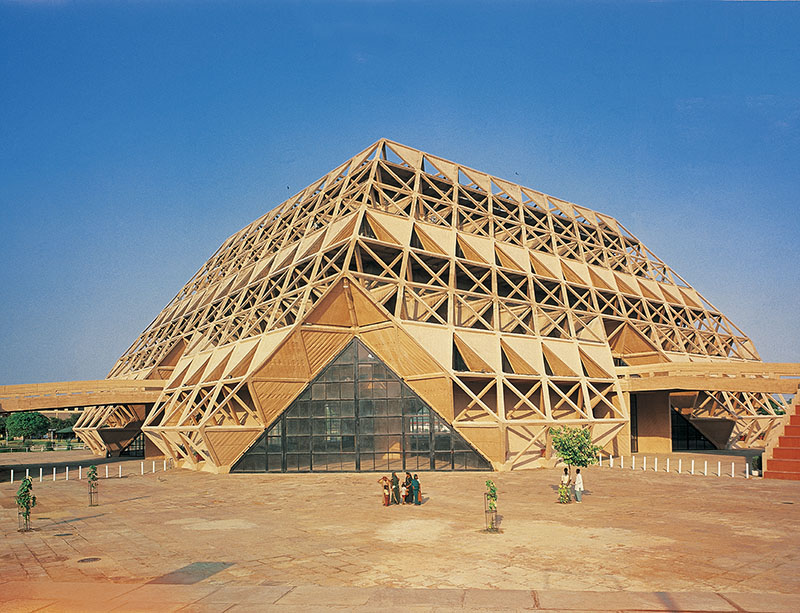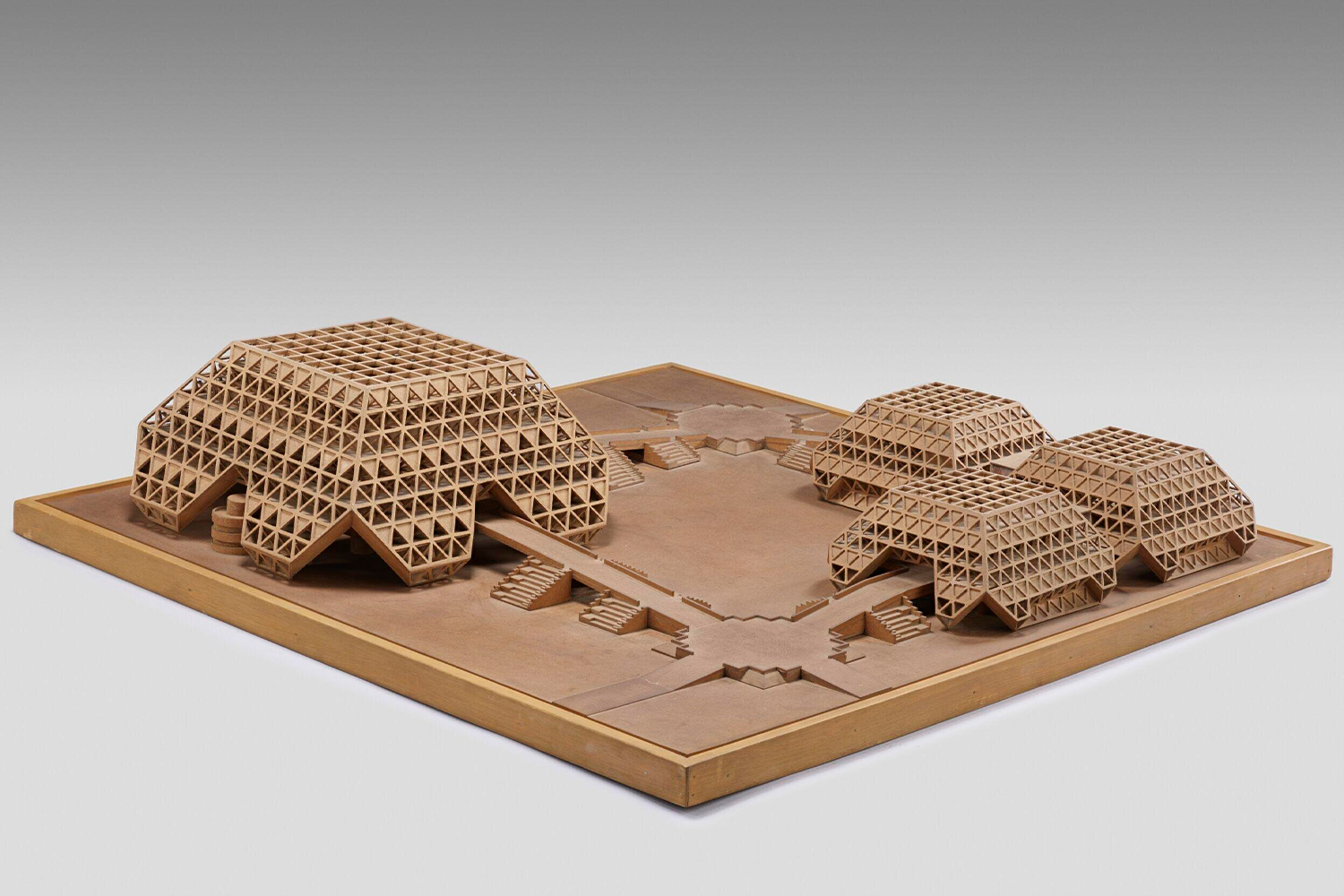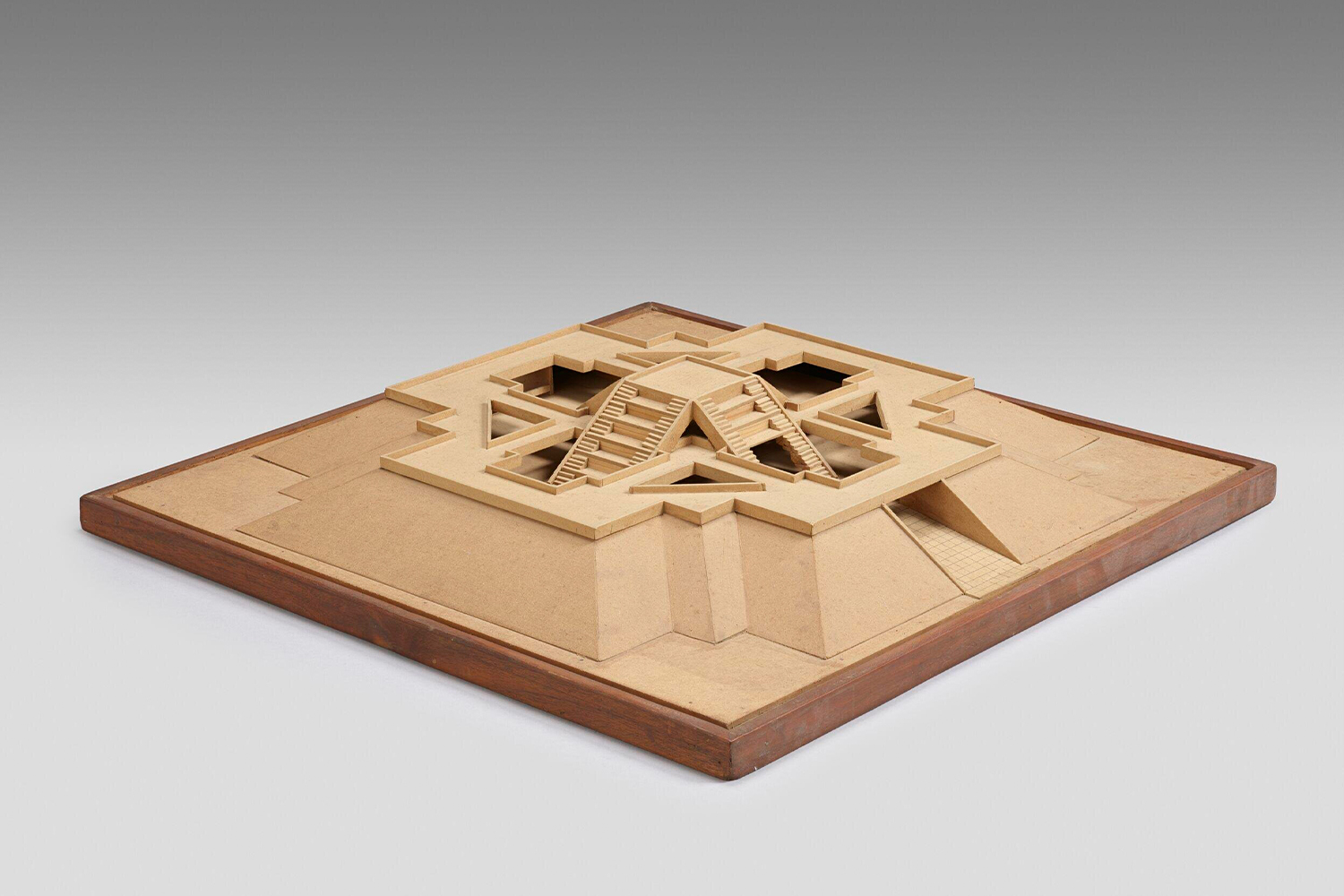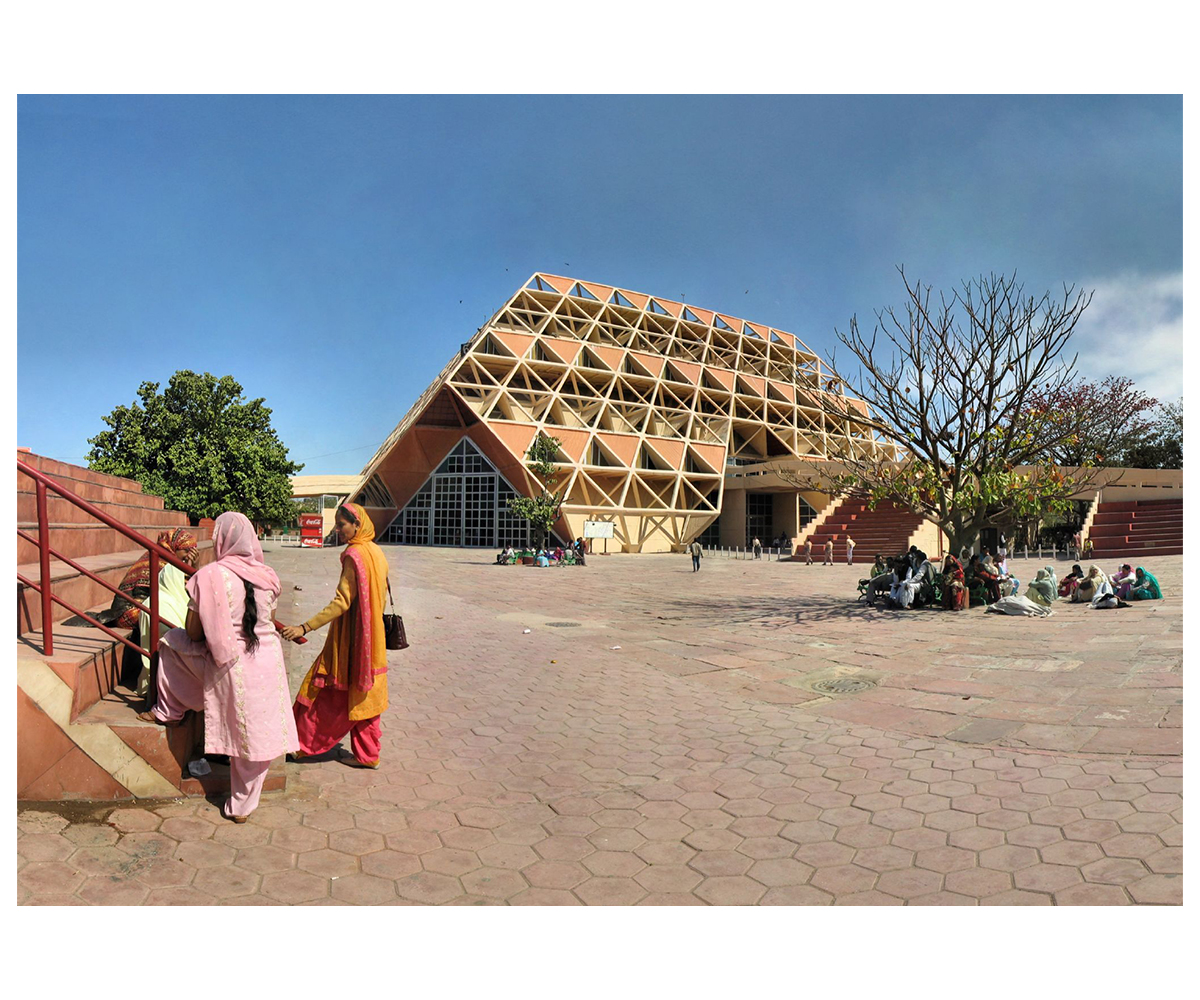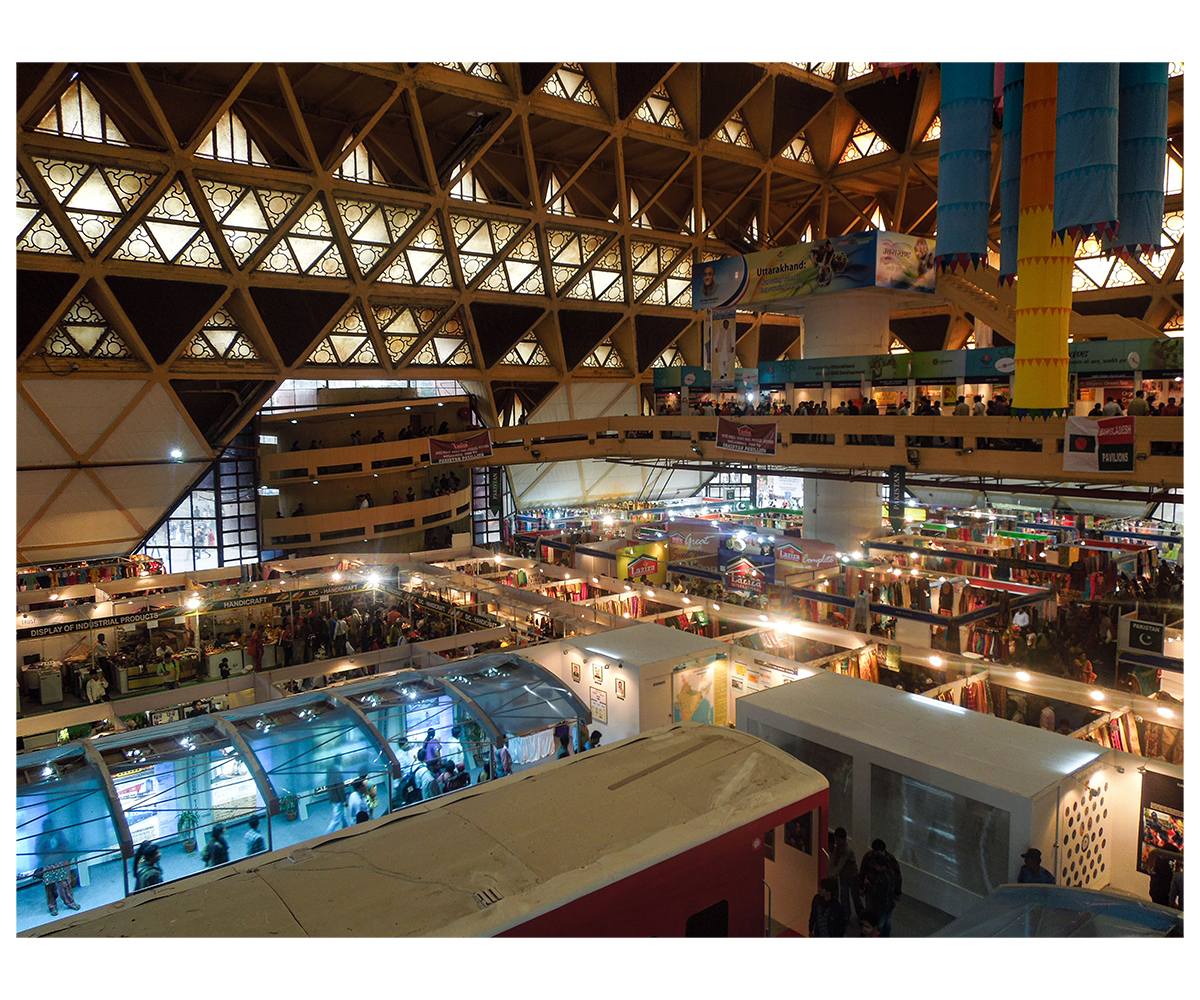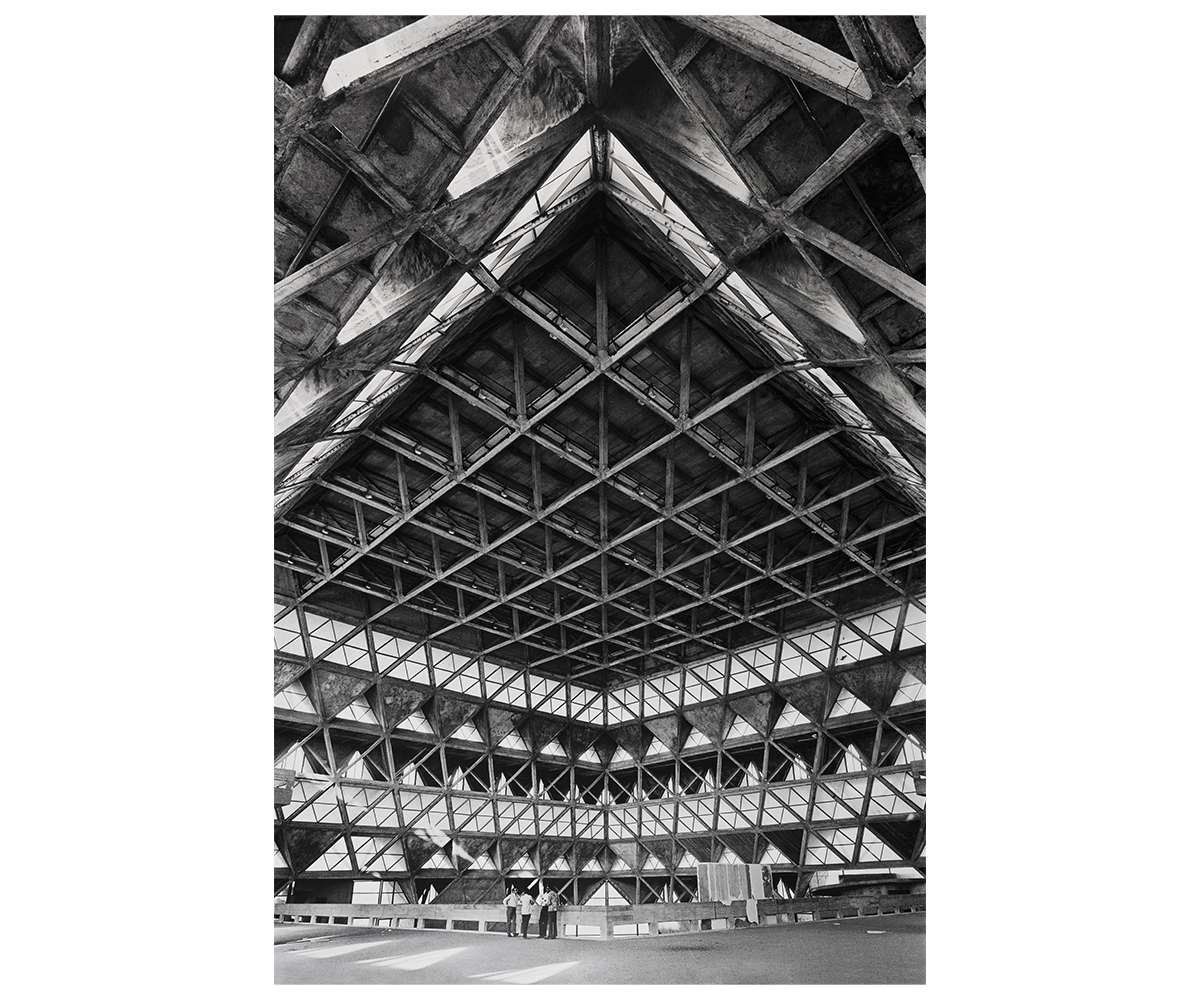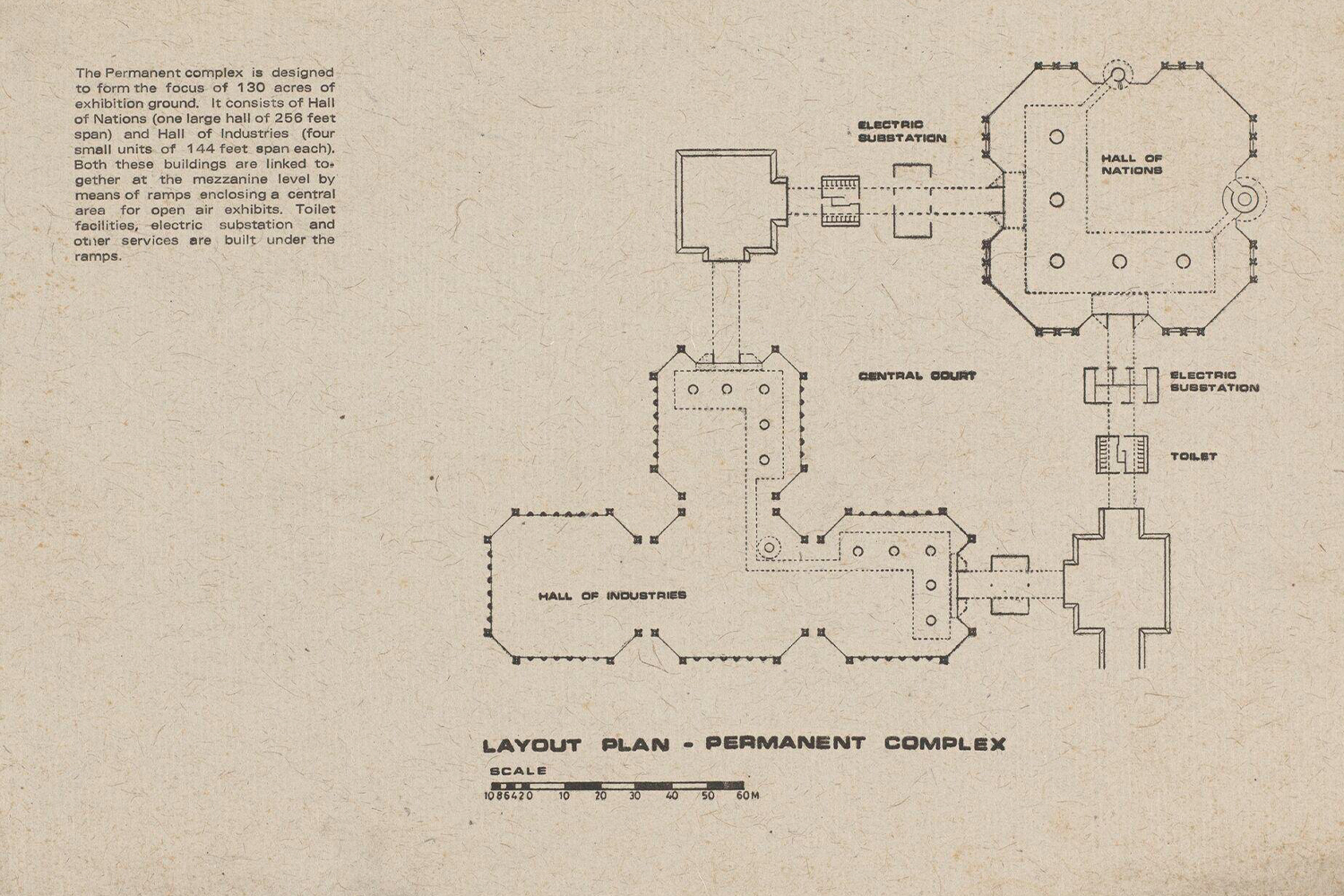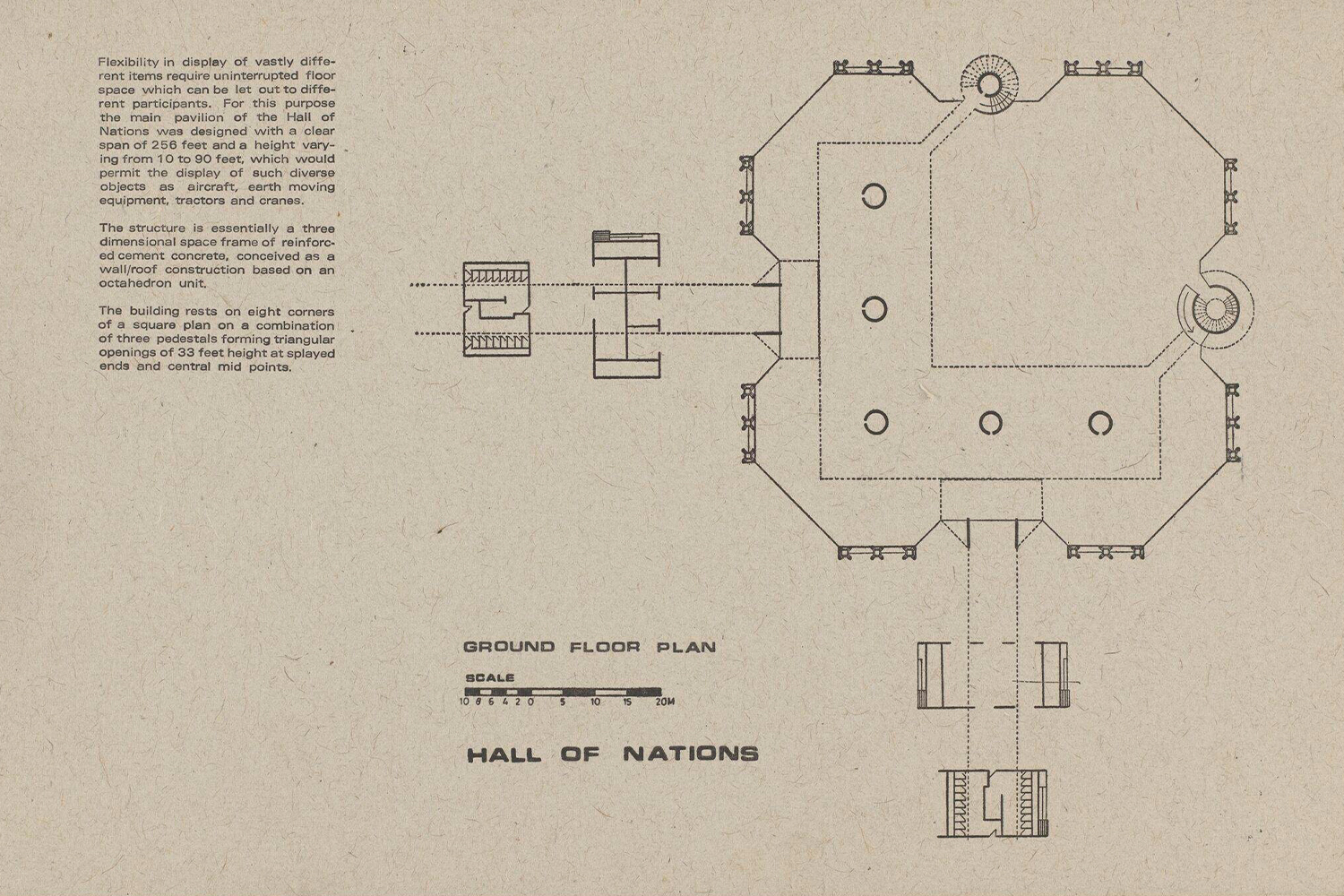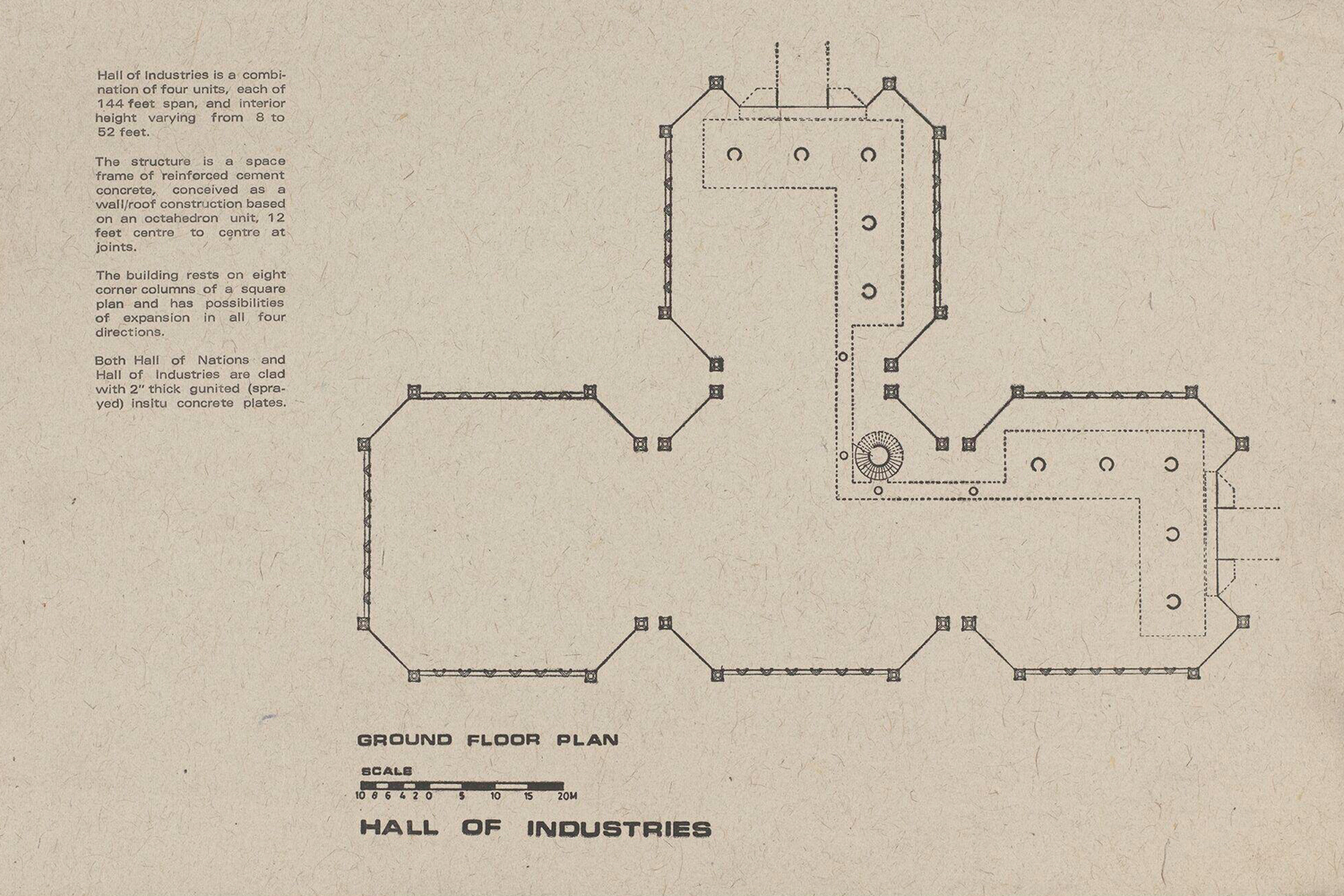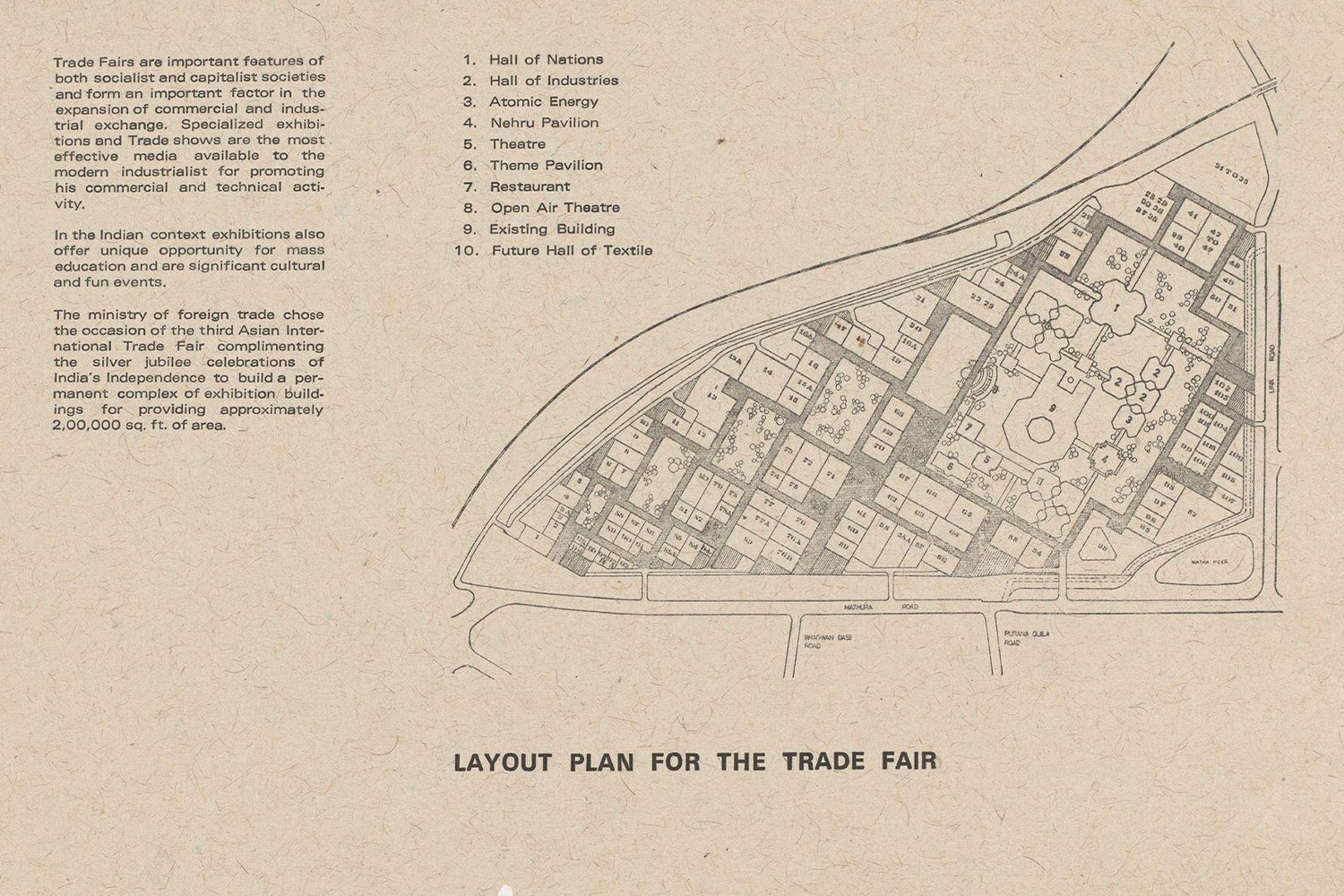ARTICLE
Hall of Nations
Structure
The Hall of Nations took the form of a truncated pyramid (pyramid with a flat instead of pointed top) with chamfered corners, creating eight vertices as anchor points at the base. The shell was a space frame structure composed of tetrahedral, or triangular pyramid, concrete units, each almost 5 metres wide, with some of their faces open and others closed with concrete cladding. Such a structure allowed for a vast, column-free interior space while remaining visually and materially light yet robust. The interior had a span of 78 metres across at the base, with a height rising from 3 metres at the edges to 21 metres in the centre, with multiple mezzanine levels. This allowed it to accommodate displays of varying sizes, from small objects to large industrial machinery.
This main pavilion was connected via ramps and staircases at the mezzanine level to the Hall of Industries, four adjoining structures that were smaller-scale replicas of the Hall of Nations — each 40 metres across at the base, with a height of 18 metres, using proportionately smaller tetrahedral units. Utilities, including electric substations, were accommodated under the ramps, which were routed so as to create a central court between the structures for open-air exhibitions. While the Hall of Nations featured an identical pattern of openings and clad surfaces on all sides, the faces of the Halls of Industries featured varying patterns based on various needs. The structures’ geometry along with the alternating rows of closed and open faces in the tetrahedral modules protected the interior from the harsh sun of Delhi, while allowing for natural ventilation. This passive cooling system mitigated the need for energy-intensive air conditioning.
The structural vocabulary of the complex reflects various architectural influences. The highly geometric design, rooted in a precise mathematical relationship between the overall structure and its constituent modules, reflects a Modernist architectural aesthetic; the large-scale use of unembellished concrete, evokes the raw monumentality of Brutalist architecture. The use of the space frame as a vast, three-dimensional jaali draws on the lattice screens of Indo-Islamic and earlier Indian architecture; the chamfered corners were influenced by Humayun’s Tomb.
Design considerations
The design and engineering of the structure emerged from economic considerations and the availability of materials and labour in India at the time. The space frame was chosen as the structural system because, aside from its inherent strength, it could be used for both the walls and the roof, and easily adapted to the smaller scale of the Hall of Industries. However, prefabricated modules for space frames were unavailable in India and typical materials such as steel struts were prohibitively expensive and difficult to source. Raj and Rewal chose concrete, which was easily available and economically viable, though it had never previously been used for a space frame of this scale anywhere in the world.
Skilled and unskilled manual labour familiar with concrete was readily available. Approximately three hundred worker families were employed and housed on site. The space frame units were cast in-situ by manually pouring concrete into wooden moulds built by a team of fifty carpenters. The geometry of the interlocking tetrahedral modules, resulting in rhombic sections, had up to twelve members or struts joining at a single node in a way that balanced the acting forces for great load-bearing capacity; this eliminated the need for support columns within the space. The construction sequence was also carefully worked out so that scaffolding was not needed beyond a certain height — the structure itself supporting further additions — thus reducing building time and effort. These decisions were part of what Rewal called ‘intermediate technology’ — practical and context-appropriate design solutions that sought to integrate both indigenous building practices and industrial techniques.
The Hall of Nations came to be recognised in the international architectural fraternity and in museums and universities around the world for its design and ingenuity in the use of materials and labour. In India it was featured on postage stamps issued in 1987 and 2002, in the latter case depicted alongside the Sanchi Stupa.
Demolition
As part of a redevelopment plan for Pragati Maidan unveiled in 2015, the Hall of Nations complex, including the Nehru Memorial Pavilion, was demolished in April 2017 by the Indian Trade Promotion Organisation (ITPO) — a body of the national Ministry of Commerce and Industry. A new convention centre, the Bharat Mandapam, was later built in its place. The decision to demolish the Hall of Nations sparked outrage and grief within the architectural community and among heritage conservationists globally, and was widely criticised for its perceived disregard for India’s Modernist architectural heritage. The ITPO justified its actions by citing a ruling of Delhi’s Heritage Conservation Committee (HCC) — a body under the Ministry of Urban Development — which only recognised buildings over sixty years old as constituting modern architectural heritage, a ruling criticised by some for deferring to real estate interests.
Critics of the demolition argued that the Hall of Nations, although falling short of the sixty-year threshold, possessed verifiable cultural value as an example of Indian Modernist architecture. The demolition has also been viewed as part of a larger cultural reform movement by the Narendra Modi-led Bharatiya Janata Party government, which adopts a Hindu revivalist ideology known as Hindutva, in contrast to the Modernist attitude of the INC, especially under Nehru.
Preservation efforts
Opposition came largely in the form of public petitions and pleas to the Indian government, including an open letter to the prime minister from Rewal and Raj. Global institutions such as the International Union of Architects — representing over 1.3 million architects across 120 countries — as well as the Centre Pompidou in Paris, the Museum of Modern Art in New York, and ETH Zurich also wrote to the government urging it to reconsider the demolition. They cited the structure’s value as an architectural and cultural landmark that had found continued relevance in international architecture curricula. Outside of academic and architectural communities, however, there was a lack of any significant populist objection in India.
Rewal as well as the Indian Institute of Architects (IIA) and the Indian National Trust for Art and Cultural Heritage (INTACH) filed petitions in defence of the building at the Delhi High Court; they lost these cases. While they were preparing to appeal to the Supreme Court, the complex was demolished.
Legacy
As a critique of the demolition and to memorialise the Hall of Nations, the organisation Architexturez South Asia, launched a project titled Hall of Nations, Transposed! — which invited submissions reimagining the building in various historical, contemporary, or mythical settings.
Photographs and models of the Hall of Nations have been exhibited at institutions such as the Centre Pompidou in Paris and the National Gallery of Modern Art in New Delhi. Rewal’s model of the Hall of Nations and Hall of Industries is now housed in the Victoria and Albert Museum in London.
Bibliography
Architexturez. “Letters in Support of an Appeal to Save the Hall of Nations, Pragati Maidan.” Accessed April 29, 2025. https://architexturez.net/pst/az-cf-182043-1491284631?utm_medium=website&utm_source=archdaily.com.
Architexturez. “Hall of Nations and Nehru Pavilion.” Accessed April 29, 2025. https://architexturez.net/doc/az-cf-123722.
Heritage Conservation Committee. “Minutes of 53rd Meeting of the Heritage Conservation Committee Held on February 2, 2017.” Accessed February 17, 2025. https://hccdelhi.in/Upload/Link%20Page/Minutes%20of%20Meetings/903675640859281.pdf.
Kochupillai Malini. “Save Pragati Maidan: It Isn’t Just a Set of Exhibition Halls; It’s a Treasure of Indian Architecture.” Scroll.in, November 24, 2015. Accessed April 29, 2025. https://scroll.in/article/771066/save-pragati-maidan-it-isnt-just-a-set-of-exhibition-halls-its-a-treasure-of-indian-architecture.
Lang, Jon, Madhavi Desai, and Miki Desai. Architecture and Independence: The Search for Identity — India 1880 to 1980. Delhi: Oxford University Press. 1997.
Langar, Suneet Zishan. “The Demolition of Delhi’s Hall of Nations Reveals India’s Broken Attitude to Architectural Heritage.” Arch Daily, June 23, 2017. Accessed October 14, 2024. https://www.archdaily.com/874154/the-demolition-of-delhis-hall-of-nations-reveals-indias-broken-attitude-to-architectural-heritage.
Mehta, Vandini, Rohit Raj Mehndiratta, and Ariel Huber. “Hall of Nations and Halls of Industries, New Delhi, 1972.” In The Structure: Works of Mahendra Raj. Chicago: University of Chicago Press, 2016.
Raj Rewal Associates. “Hall of Nations, Pragati Maidan, New Delhi.” Accessed October 14, 2024. https://rajrewal.in/portfolio/hall-of-nations-new-delhi/.
Rewal, Raj. “Layout Plan: Permanent Complex.” Presentation screenprint. 1970. Victoria and Albert Museum. https://collections.vam.ac.uk/item/O1770519/print-rewal-raj/.
Raje, Shubhra, and Anand Bhatt. “Hall of Nations, Transposed!.” Architexturez Imprints. Accessed October 14, 2024. https://architexturez.net/doc/az-cf-181798.
Senses Atlas. “Hall of Nations, Pragati Maidan, Raj Rewal.” July 1, 2024. Accessed October 14, 2024. https://www.sensesatlas.com/hall-of-nationspragati-maidan-new-delhi/
Stierli, Martino. “Remembering the Hall of Nations, New Delhi.” post, August 29, 2017. Accessed October 14, 2024. https://post.moma.org/remembering-the-hall-of-nations-new-delhi/.
Turner, Christopher. “July 2024: Hall of Nations and Nehru Pavilion, Delhi.” The Twentieth Century Society: Building of the Month. Accessed October 14, 2024. https://c20society.org.uk/building-of-the-month/hall-of-nations-and-nehru-pavilion-delhi.




